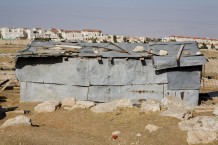Bimkom launches mini-site dedicated to Jahalin in E1

The Bedouin communities scattered throughout the area between East Jerusalem and the outskirts of Jericho comprise some 7,500 residents, most of whom belong to the Jahalin tribe (‘ashirah), though some belong to the Ka’abnah tribe; both tribes share a similar history that led them to their present situation. Until 1948, the Jahalin tribe resided in the area of Tel Arad in the Negev, and was thought to be one of the largest Bedouin tribes in the area. Like other Bedouin tribes in the Negev, the Jahalin became semi-nomadic, such that already in the 19th century, they were living in permanent localities and only some of the population was leading a nomadic life, which was only partial, timed with seasonal grazing purposes. Most family members carried on with their life routines in a permanent location throughout the year, while some would set out during particular seasons with the flocks to graze in more distant areas, returning at the end of the grazing season to their homes. This was a pattern that dated to the Ottoman Period, when the Bedouin tribes in the Negev first began determining and agreeing on permanent land arrangements between them, until almost complete stabilization was achieved in the 19th century. The boundaries of each tribe’s living area were defined, and partial nomadic patterns existed during the grazing seasons, mainly within the living area (“deirah”) of each tribe (read more about the Jahalin)
The Bedouin communities scattered throughout the area between East Jerusalem and the outskirts of Jericho comprise some 7,500 residents, most of whom belong to the Jahalin tribe (‘ashirah), though some belong to the Ka’abnah tribe; both tribes share a similar history that led them to their present situation. Until 1948, the Jahalin tribe resided in the area of Tel Arad in the Negev, and was thought to be one of the largest Bedouin tribes in the area. Like other Bedouin tribes in the Negev, the Jahalin became semi-nomadic, such that already in the 19th century, they were living in permanent localities and only some of the population was leading a nomadic life, which was only partial, timed with seasonal grazing purposes. Most family members carried on with their life routines in a permanent location throughout the year, while some would set out during particular seasons with the flocks to graze in more distant areas, returning at the end of the grazing season to their homes. This was a pattern that dated to the Ottoman Period, when the Bedouin tribes in the Negev first began determining and agreeing on permanent land arrangements between them, until almost complete stabilization was achieved in the 19th century. The boundaries of each tribe’s living area were defined, and partial nomadic patterns existed during the grazing seasons, mainly within the living area (“deirah”) of each tribe (read more about the Jahalin)
